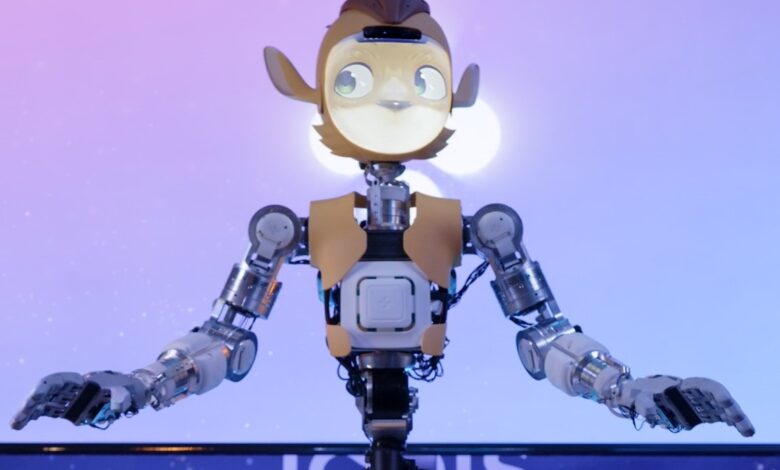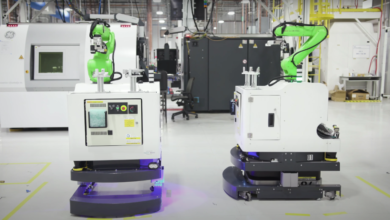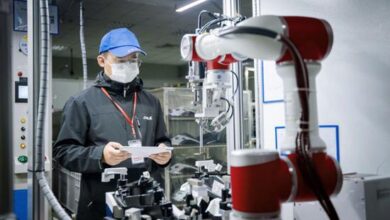
From Boston Dynamics’s new humanoid, Atlas, to the global proliferation of computerised canines, our future overlords are getting a bit too cute for comfort
By definition, a robot is “a machine controlled by a computer that is used to perform jobs automatically”. Technically, this could refer to a mechanical arm on a factory production line, or a Roomba vacuum cleaner. But let’s be honest: if you’re asked to picture a robot, you don’t think of industrial machinery or domestic tools. Partly thanks to decades of films like Ex Machina, Star Wars, WALL-E or Metropolis, you probably think of something vaguely humanoid. Eyes, a mouth, grabby little hands, etc. It’s quite likely that this imaginary robot is cute, too, although it seems counterintuitive, since we’re constantly worried about them enslaving the human race.
How did this happen? When, and why, did robots get so adorable? Is it merely an extension of what Dazed’s Günseli Yalcinkaya calls the Cute Industrial Complex in tech, or is there something deeper – and perhaps darker – at its core?
Some context: last week, the robotics company Boston Dynamics announced the retirement of its hydraulic humanoid robot, Atlas, and unveiled its all-electric replacement (also named Atlas). Yes, this sparked the usual wave of panic about the coming robot apocalypse, but with its rounded limbs, waddling walk, and empty LED stare that takes cues from the Pixar lamp, it’s also quite a bit cuter than its predecessor. Its flexible legs and inhuman mobility have even seen it branded “weirdly sexual” and – I’m sorry to report – there’s more than one “hear me out” in the comments under the unveiling.
Of course, Boston Dynamics already brought cute robotics into the mainstream when it released its signature robot dog, Spot, to the public in 2019. You might recognise the bionic pups from Coperni’s AW23 catwalk, or a carefully-choreographed music video with BTS, or the TikToks that show Spot performing ballet or line dancing, where views run in the millions. “The least scared I’ve ever been of a Boston Dynamics robot,” reads one telling comment on the latter. “They should hire you to do the marketing.”
We promise this is not a person in a bodysuit. https://t.co/S9FgfpqvrWpic.twitter.com/G30sXHQ93C
— Boston Dynamics (@BostonDynamics) April 17, 2024
On the other hand, you might remember Spot stalking the streets alongside the NYPD in 2021, in scenes reminiscent of Black Mirror, before it was pulled due to public backlash. “I think a lot of the reaction was assuming a use that the robot was not being used for, and also a set of capabilities that the robot doesn’t have,” Michael Perry, then the vice president of business development at Boston Dynamics, told Dazed later that year. “The robot is not designed to harm people, right?” But presumably that’s not what DARPA – the US agency responsible for developing new military technologies – was hoping for when it funded Boston Dynamics’ first quadruped in the mid 2000s.
Back in 2017, the late philosopher Daniel Dennett discussed the dangers of making robots cute – or, by extension, sexy, I guess – in an interview with the BBC. It’s an especially bad idea, he suggested, if they’re imbued with any sort of ‘intelligence’. Enamoured by the abilities of AI-powered tech, humanity might become too dependent on it, or even cede our “moral authority” when it comes to important decision-making. His solution? First and foremost: “Banish cutesy ‘human’ touches, which are – to put it bluntly – false advertising.”
@spot_tok_ So well rehearsed 😩🥵 Shoutout to the brilliant princeton student who put in the WORK to program the moves #robot #dance #princeton #austin #linedance #robotics #viral #fyp #spotbostondynamics ♬ original sound – Alyssa
Aesthetics do matter, after all. Elon Musk’s Tesla is often credited with revolutionising a whole industry by making electric cars look, and feel, cool to drive. Even in 2024, the quality of the technology housed inside the Blade Runner-style shell of a Cybertruck is debatable at best, but it doesn’t really matter, because many buyers have based their purchase on vibes alone. Some robot manufacturers seem to run on the same principle. Instead of making their products ‘cool’ or ‘sleek’ though, they aim for cute and personable – less Terminator or Ex Machina, and more like something out of WALL-E, or M3GAN before she goes rogue. In cases like entertainment or elderly care, this kind of makes sense, but do automated warehouse workers and security bots really need to win our affection? Well, it might make the job replacement easier to swallow…
The point is, Atlas, Spot, or any other robot that elicits warm, fuzzy feelings when it’s shown doing something innocent and adorable on the internet should also trigger a healthy dose of suspicion. What’s going on under the shell and, more importantly, behind the scenes at the companies that raise money via these friendly-faced creations? It’s worth mentioning here that Boston Dynamics – alongside other major robotics companies – pledged not to “weaponise” its robots in 2022, although it apparently has no problem being owned by Hyundai group, which oversees the production of tanks and military drones for sketchy companies like Palantir.
Regardless, critics have pointed out that the cat (or robot dog) is already out of the bag, with many similar machines popping up across the world. Unless stricter treaties are brought into effect, it’s not a question of will robots be weaponised, but who will deploy them first. After that, we’ll likely be locked in a Molochian race to the bottom. It’s only so long until someone arms a mechanical canine with a flamethrower, and… oh wait, they have, and it’s already on sale.
All of that said, cute robots aren’t going away. By 2028, the global robotics industry is projected to generated more than $65 billion in revenue. Players like Elon Musk will be looking to set themselves apart from the competition via their aesthetics, alongside startups such as Enchanted Tools, a developer of anime-inspired bots on a mission to “change the face” of robotics. In fact, even when robots aren’t cute we’re obsessed with trying to make them so. Humans stick googly eyes on cleaning robots (even as they steal new opportunities for work), fret over the meaning of life for a robot arm, personify their vacuum cleaners, and mourn the demise of space rovers as if they are their first-born child.
So how can we correct our delusions about the cute, cuddly nature of our future overlords? For starters, we could take Dennett’s advice, and get rid of their more appealing aspects. Wipe the smile off their face, peel back the silicon mask, and expose the machinery behind their uncanny expressions (trust me, you won’t want to snuggle up to a skinless automaton – just look at Disney’s example below).
Taking that thought a step further, maybe we could even start producing more explicitly scary and inhuman robots, to balance things out. See, for example: the giant robot spider that Grimes rode to her Coachella set, or NASA’s creepy little snake bots. That way, we can come to terms with a dystopian future where bands of bloodthirsty robots roam the Earth before it (hypothetically) becomes a reality. Ironically, of course, you won’t even see the really dangerous ones coming.



